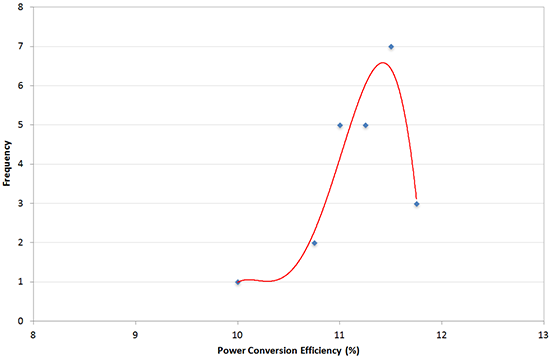
A formulation of methylammounium iodide (MAI), PbCl2 and PbI2 at a molar ratio of 1:1:4 (PbCl2:PbI2:MAI) in a DMF solvent. On processing, I201 ink can be used to create a CH3NH3PbI3-xClx perovskite film. The process recipe for I201 is optimised for glove box processing under a nitrogen atmosphere.
I201 perovskite ink is divided into 10 lots of 0.5 ml. We have found this quantity to be sufficient for 10 individual experiments (approximately 160 device substrates).
Datasheet
We have specially formulated I201 Perovskite Ink in our laboratories to make it suitable for deposition by spin-coating. It is based on similar ink formulations used in references [1]. This ink is designed to be used with a bottom ITO/PEDOT:PSS anode and a top PC70BM/Ca/Al cathode, with PV devices fabricated with an average / peak power conversion efficiency (PCE) of (11.2% ± 0.4)% / 11.8%. This performance level is in accord with other literature reports using similar ink formulations where PCEs of approximately 11.5% have been demonstrated [1]. A full process recipe comes with the ink, which is ready to use after heating for a short time.

References (please note that Ossila has no formal connection to any of the authors or institutions in these references):
- Reproducible One-Step Fabrication of Compact MAPbI3-xClx Thin Films Derived from Mixed-Lead-Halide Precursors, D. Wang et al., Chem. Mater., 26, 7145-7150 (2014) DOI: 10.1021/cm5037869
Specifications
Perovskite precursor ink formulation: Ink I201 is based on a mixture of methylammonium iodide (MAI), lead chloride (PbCl2) and lead iodide (PbI2) at a molar ratio (PbCl2:PbI2:MAI) of 1:1:4 dissolved in anhydrous DMF (dimethylformamide).
| Compound | Purity | Molar Ratio |
|---|---|---|
| MAI | > 99% (as measured by Elemental Analysis) | 1 |
| PbCl2 | 99.999% | 1 |
| PbI2 | 99.999% | 4 |
| DMF | 99.8% | n/a |
Now selling bulk orders of 30ml with a 25% discount over our standard order sizes.

Usage Details
Fabrication Routine for Perovskite Precursor Ink I201
Glass / ITO / PEDOT:PSS / CH3NH3PbI3-xClx / PC70BM / Ca / Al
For complete step-by-step instructions please see our Full Perovskite Solar Cells Fabrication Video or written fabrication guide. Please note, however, that the routine in these full guides differs slightly to the optimised routine for the I201, which is designed to be processed in a nitrogen filled glove box.
The summary below outlines the key steps required when processing I201 ink. You can also download this summary as a PDF in order to print and laminate it for us in a clean room.
1. Substrate clean (in air):
- Sonicate ITO substrates for 5 minutes in hot (70°C) 1% Hellmanex
- Dump-rinse substrates twice in boiling, deionised (DI) water
- Sonicate for 5 mins in IPA. Dump-rinse twice in boiling DI water
- Dry the substrates with nitrogen gun
- Bake the substrates on a hotplate at 120°C.
2. PEDOT:PSS anode preparation (in air):
- Filter AI 4083 PEDOT:PSS using a 0.45 µm PES filter
- Dispense 35 µl of the filtered PEDOT:PSS solution onto the heated ITO substrate spinning at 6000 rpm for 30s
- Place substrate onto a hotplate at 120°C
- After all ITO substrates have been coated with a PEDOT:PSS layer, transfer all to a nitrogen-filled glove box and place onto a hotplate at 120°C for 20-30 mins
- Remove the substrates from the hotplate and allow to cool at room temperature.
3. Perovskite deposition (in nitrogen glove box):
- Heat I201 ink for 2 hours at 70°C and then cool to room temperature
- Place the ITO coated substrate (at room temperature) onto the spin-coater and spin the substrate at 4000 rpm (for 30s)
- Dynamically dispense 30 µl of I201 ink
- Place substrate back onto the hotplate (in the glove box) at 80°C
- Once all substrates have been coated, anneal for 90 mins
- After 90 mins, use a cleaning swab dipped in a small amount of DMF solvent to wipe the cathode stripe clean
- After cleaning, anneal for an addition 20-30 mins at 80°C to remove any residual DMF solvent
- After this time, remove substrates from the hotplate and cool to room temperature.
4. PC70BM deposition (in nitrogen glove box):
- Prepare a solution of PC70BM at 50 mg / ml in chlorobenzene and stir for 3 to 5 hours
- Place perovskite coated substrate onto the spin-coater and spin at 1000 rpm
- Dispense 20 µl of PC70BM solution onto the substrate (while spinning) and spin for a total time of 30s.
5. Cathode deposition:
- Thermally evaporate a calcium/aluminium cathode (5 and 100 nm respectively) through shadow-mask
- Encapsulate devices using a glass coverslip and encapsulation epoxy
- Expose to UV radiation (350 nm) for 30 mins to cure epoxy.
Perovskite Photovoltaic Device Performance
Below are device characteristics for our best pixel fabricated using the I201 fabrication recipe described above.
JV curves demonstrate the hysteresis observed from the device and include device metrics for both forward and reverse sweeps. The pixel presented (from a reverse sweep) had a power conversion efficiency of 11.8%, a Voc of 0.91 V, a FF of 79% and a Jsc of -16.5 mA/cm2.


To the best of our knowledge the technical information provided here is accurate. However, Ossila assume no liability for the accuracy of this information. The values provided here are typical at the time of manufacture and may vary over time and from batch to batch.
ebiomall.com






>
>
>
>
>
>
>
>
>
>
>
>
TUNEL的缺点是:1),操作要求高,组织样本需要固定(即使是培养细胞,也需要固定),不恰当的固定方法对实验结果影响很大,导致背景过高或者信号过弱,因此实验结果重复性不好;有的人花上半年做一个体内的TUNEL是一点都不奇怪的。2),大部分诱导凋亡的药物也引起DNA损伤,从而产生DNA断裂,易引入假阳性;3)凋亡晚期细胞基因组大量降解,导致TUNEL标记反而减少,因此此法反应的是早期凋亡比例,不能严格反应凋亡比例,属于半定量研究。
尽管有如此多缺点,但由于其是目前为数不多的能原位标记凋亡细胞的方法,因此用于组织体内凋亡研究仍然是首选。但体外细胞实验研究,很少用此法。
凋亡检测中,TUNEL并不是过时的方法,现在研究凋亡的文献仍然常见。而且相反,还比以前多一点,因为现在体内实验越来越多了,甚至线虫的凋亡研究,都用TUNEL。
凋亡研究中,的确有几种方法过时了,当然是因为有替代方案了,比如DNAladder,电镜。至于AnnexinV是不能用来和TUNEL一起评论的,前者用于细胞,而且主要是悬浮细胞,后者主要用于组织。虽然有人也做镜下的AnnexinV观察,TUNEL的细胞staining,但这都不是主流。
回到lz的原帖,的确如大家所言,做贴壁细胞,不推荐用TUNEL。如果是经典凋亡途径,只是确定比例,用最经典,最常用的subG1法即可,如果是不确定是否是凋亡,用AnnexinV,不过贴壁细胞用此法,要注意消化时间。
想请问下那个公司有专门的蛋白质荧光标记试剂盒出售。最好的是CY5的,我准备做三标。性价比越高越好
那些做过的前辈们指导一下。
探针
ddH2O36.25ul
buffer(瓶3)5ul
核苷酸混合液(含DIG-dUTP)(瓶2)2.5ul
dNTPStockSolution(瓶4)2.5ul
引物F1ul(10pmol/ul)
R1ul(10pmol/ul)
酶(瓶1)0.75ul
DNA1ul(100pg)
程序:35个循环,退火温度55度。
第一次通过探针标记得到了相应的PCR标记产物,亮度和对照相当,片段大小比标记的探针模板大,证明整个过程应该没有问题。
但一个月后重新用相同的体系,相同的程序,只是探针模板的量不同却什么都扩不出来。不知道问题出在哪了!
其检测原理为:在正常的活细胞中,磷脂酰丝氨酸(phosphotidylserine,PS)位于细胞膜的内侧,但在早期凋亡的细胞中,PS 从细胞膜的内侧翻转到细胞膜的表面,暴露在细胞外环境中。Annexin-Ⅴ(膜联蛋白-V)是一种分子量为35-36KD的Ca2+ 依赖性磷脂结合蛋白,能与PS高亲和力结合。可通过细胞外侧暴露的磷脂酰丝氨酸与凋亡早期细胞的胞膜结合。
操作步骤:
1.从室温平衡20min后的铝箔袋中取出所需板条,剩余板条用自封袋密封放回4℃。
2.设置标准品孔和样本孔,标准品孔各加不同浓度的标准品50μL;
3.样本孔中加入待测样本50μL;空白孔不加。
4.除空白孔外,标准品孔和样本孔中每孔加入辣根过氧化物酶(HRP)标记的检测抗体100μL,用封板膜封住反应孔,37℃水浴锅或恒温箱温育60min。
5.弃去液体,吸水纸上拍干,每孔加满洗涤液(350μL),静置1min,甩去洗涤液,吸水纸上拍干,如此重复洗板5次(也可用洗板机洗板)。
6.每孔加入底物A、B各50μL,37℃避光孵育15min。
7.每孔加入终止液50μL,15min内,在450nm波长处测定各孔的OD值。
在弱碱性(pH 8~9)、暗处、室温或40℃条件下,氨基酸的α-氨基很容易与2,4-二硝基氟苯(缩写为FDNB或DNFB)反应,生成黄色的2,4-二硝基苯氨基酸(dinitrophenyl amino acid,简称DNP-氨基酸)。多肽或蛋白质的N-末端氨基酸的α-氨基也能与FDNB反应,生成一种二硝基苯肽(DNP-肽)。由于硝基苯与氨基结合牢固,不易被水解,因此当DNP-多肽被酸水解时,所有肽键均被水解,只有N-末端氨基酸仍连在DNP上,所以产物为黄色的DNP-氨基酸和其它氨基酸的混合液。混合液中只有DNP-氨基酸溶于乙酸乙酯,所以可以用乙酸乙酯抽提并将抽提液进行色谱分析,再以标准的DNP-氨基酸作为对照鉴定出此氨基酸的种类。因此2,4-二硝基氟苯法可用于鉴定多肽或蛋白质的N-末端氨基酸。









